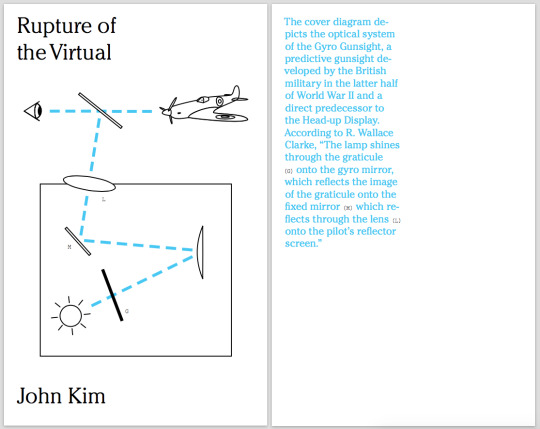#ruptureofthevirtual
Text

Rupture of the Virtual
John Kim
Rupture of the Virtual is an examination of a concept of the material and the invaluable resources it offers for critical thinking today. In a multifaceted analysis, the book considers the theoretical reasons for the material’s exclusion from media theory and details the military origins of computing interface technologies, such as the Head-up Display and Augmented Reality, that enhance knowledge over the material. Rupture of the Virtual insists that a renewal of the material can be central to a critique of the virtual as a cultural condition.
ORDER a book.
DOWNLOAD the interactive PDF.
Table of Contents
1 Introduction
2 A New Materialism for New Media Studies 19
3 The Origin of the See-Through Graphical Interface 43
4 Encounters with the Material: Krzysztof Wodiczko and Site-Specific Media Art 69
5 Materiality in Site Responsive Media Art 95
6 Rupture of the Virtual 121
7 Conclusion 145
Notes 153
Index 167
Keywords: new media theory, augmented reality, head-up display, virtual reality, mixed reality, military, computing history, military history, graphical user interface, GUI, see-through graphical interface, stgi, art, aesthetic, critical theory, gyro gunsight, site specific, site responsive
http://www.johnwkim.name/rupture
0 notes
Text
Whither the Material in New Media Studies?
Read article in communication+1: special issue on new materialisms
Title:
Whither the Material in New Media Studies?
Abstract:
This article addresses how new media theory has been founded on an endemic exclusion and erasure of a concept of the material, because of the ascendancy of a concept of the virtual in theoretical and historical research on the development of new media technologies. In order to develop this claim, three influential accounts of the virtual in media studies are reviewed (the history of technologies of the virtual, embodiment and informatics, and post-structuralist theories of digital media) in order to demonstrate how each is grounded in an exclusion of the material. On the basis of this analysis, the article poses a definition of the material that responds to, but is not informed by, these exclusions, one that acknowledges the media’s role in enabling or enhancing one’s capacity to cognize the things in one’s immediate physical surroundings.
Keywords:
Material, virtual, media, new media, immediate, physical, embodiment, digital, exclusion, see-through graphical interface, augmented reality, supplementarity
0 notes
Text
The Origin of the See-Through Graphical Interface
Read article in Convergence: The International Journal of Research into New Media Technologies

Title: The Origin of the See-Through Graphical Interface: World War II aircraft gunsights and the status of the material in early computer interface design
Abstract: This article defines a new category of media technologies, the See-Through Graphical Interface, which are interface devices that project graphical information into a user’s field of view. This category includes technologies as diverse as Head-up Displays, Augmented Reality, military gunsights, and others. This article identifies and discusses the first See-Through Graphical Interface, the British Mark II Gyro Gunsight, a computing gunsight used in the cockpits of fighter aircraft during the latter half of World War II. On the basis of an analysis of the design and history of this gunsight, this article considers the See-Through Graphical Interfaces’ implications for prevailing ideas on virtuality, materiality, human-computer interaction and media history.
Keywords: See-Through Graphical Interface, Augmented Reality, gyro gunsight, Head-up Display, material, virtual, virtuality, Graphical User Interface, computing history, military history
0 notes
Text
Rupture of the Virtual (book manuscript)
A book project on cultural practices that open encounters with the material as interventions into the virtual condition. It addresses subjects ranging from alternative histories of the computer interface to site-specific media artwork. (Chapters forthcoming.)
0 notes